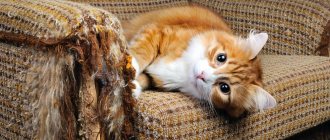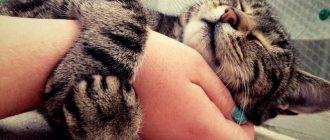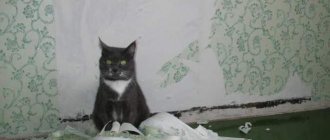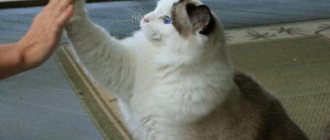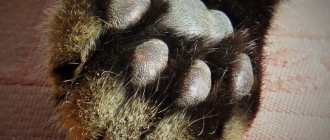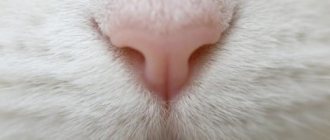Who doesn't love cats? Fluffies with soft bellies and scratchy paws can touch anyone. Unfortunately, every cat can be “Darth Vader from the dark side of the Death Star”: animals damage furniture by scratching sofas and armchairs. We will tell you below how to deal with the fact that a cat sharpens its claws and tears up furniture.
To stop a cat from tearing up furniture you need patience, calmness and ingenuity.
Is your cat scratching his claws on furniture?
Scratching is an innate need in felines.
Have you seen Animal World? We saw that not only cats, but also tigers and lions love to sharpen their claws on some baobab tree. This is how animals mark their territory by sharing their scent and signaling to other individuals: “I am scary and menacing, run in fear!” By scratching their claws on furniture, cats take care of hygiene.
When a cat peels off the upholstery of upholstered furniture, it leaves dead scales of claws on it.
Cats' claws fall off - this is a known fact. While vacuuming the carpets in the house, have you ever found cat claws? No! There is no need to worry about severed cat claws and think that the poor pussy has suffered. This is a completely natural process and by sharpening their claws on pieces of furniture in the house, cats help the scales on their paws peel off.
If a cat's claws peel off and fall off by themselves without causing any inconvenience to the animal, then this is quite normal.
Often, a cat, doing such a useful procedure as grinding its claws, spoils the owner’s favorite sofa, chair or bed
A number of cats get rid of their worries by sharpening their claws on furniture. It is better for you not to upset the cat; the animal will not keep you waiting and will take revenge on the nearest sofa.
Cats care what they sharpen their claws on: some like a hard surface, others like a soft one.
This is how cats train. Animals tear at chairs, practicing extending their claws from their paws: this is an irreplaceable thing needed for hunting and obtaining food. Your cat always has whiskey in his bowl, and he doesn’t have to worry about food. But evolution is evolution. If a cat is supposed to hunt for mice, he will do this by training his skills on the furniture.
The cat uses its claws as nimble tools
Why do cats tear up sofas?
The answer to this question lies in the nature of the cat family. Any cat has a set of instincts that it has preserved and displays at home. Why do cats scratch furniture and wallpaper? Let's look further.
Indicate the boundaries of their territory
There are glands near the pads of a cat's front paws. By scratching a suitable surface, the cat stimulates them to release an odor that is imperceptible to the human sense of smell, but noticeable to cats. In addition, a visual mark is used - scratches.
Sharpening claws
The renewal of the stratum corneum of a cat's claw occurs by shedding its top layer. To do this, the cat chews it off or gets rid of it with the help of the owner's favorite carpet.
By tearing up wallpaper, cats sharpen their claws.
Stretch their paws
By scratching furniture and carpets, the cat stretches its muscles, stretches, and trains its claw retraction mechanism. This is exercise for the cat.
Relieve stress
By scratching surfaces, the animal relieves nervous tension. If the situation in the house is tense, cats often scratch wallpaper and furniture.
Kittens also scratch objects that interest them. Most often, they do this for informational purposes. Tactile sensations help the kitten explore the object and its properties. Juveniles may scratch furniture as they play, clinging cheerfully to them like a wild cat.
Each cat prefers its favorite material for sharpening its claws: some prefer vinyl wallpaper, while others only like carpet.
Cats can also tear wallpaper due to extreme stress.
How to stop a cat from tearing up furniture
Claws must be trimmed very carefully so as not to damage soft tissues.
You can remove the claws of an animal: it is impossible to stop a cat from tearing up furniture. The manipulation is called onychectomy, and it is done in any veterinary hospital. Let's call this method the most popular way to save sofas from the attack of cat paws. But this is an operation, and not every cat owner will take such measures when a damaged sofa stands between the pet and the owner. The cat needs to be given anesthesia - this does not go unnoticed for the body.
Metal nippers for trimming cat claws
A cat deprived of claws is an inferior animal that can be considered a real disabled person. He will not be able to play, scratch, or fully jump.
Cutting a cat's claw in the right, wrong and dangerous positions
A cat can fall off the balcony ledge if it likes such walks: the animal will not catch its claws on the edge. This method will damage the cat’s posture, and the animal will begin to live in constant stress.
The location of a cat's toe inside the foot when walking
Personal areas, scratching post and cat area
Having established your favorite places for pranks, you have two alternatives: place a scratching post or ward off the cat using special products (sold in pet stores). You can also purchase a special spray , the composition of which attracts the cat’s attention or literally improves its mood. Using auxiliary tools, you can quickly consolidate positive emotions associated with an area, place or specific object (scratching post).
Tip: Most cats love to stretch and extend their claws when greeting their owner. By placing a scratching post near the front door, you will encourage your pet’s self-esteem and protect the wallpaper!
There are many models of scratching posts: slats, mats, posts, beds and even play complexes. All types of accessories have one requirement in common - strong fixation. If the scratching post falls on the cat, moves sharply from its place, scares it, then you will have to remove it or replace it with a new one (another model).
Important! If you have several cats, each of them should have a personal scratching post (and preferably more than one).
Make sure that the cat has a private place to sleep and rest - calm and untouchable. As a house, you can use a box, a carrier, or special booths (sold in pet stores). This point is especially important for pets who feel constrained by artificial competition for territory.
Advice: in addition to the sleeping place, try to equip all (if possible) places the purr likes with sun loungers. Many four-legged animals prefer to lie quietly or nap in the same room with the owner.
As practice shows, it is more difficult to wean a cat from scratching wallpaper with its claws than to discourage it from furniture. The reasons are the same – designation of the territory. If all of the above methods do not help, you should think about deeper problems. Perhaps your pet suffers from depression and lack of self-confidence , and by peeling off the wallpaper, he is trying to prove to the whole world that he is not so pathetic.
Tip: Getting back to training, if your cat only scratches the walls and doesn’t touch the furniture, you might want to consider installing wall-mounted scratching posts. Believe it or not, no pet wants to be bad or scolded.
Not in all cases the owner will be able to use the spray, since it can leave marks on the wallpaper. If you are planning to renovate, take care of installing wall panels. Try to find a place to install a rope bridge (for example, from a bedside table to a closet) or a tall “scratching post” with a lounger on top. Most cats feel much more confident with access to the highest points of the home.
Note! Active cat breeds, such as Abyssinians and Siamese, have a vital need for access to elevated areas of their home.
Need to use a scratching post
Such a scratching post performs 2 functions at once - an indispensable device for a cat and a luxurious decorative floor vase.
The most humane way to save a sofa from the encroachments of a cat is to purchase a scratching post.
Folding scratching post of unusual shape with an inclined surface
Devices are offered as:
- columns;
Cat scratching post Fox – post with teaser - planks with hemp wound on them;
Corner scratching post made of planks wrapped with natural rope - shelves with terry.
DIY scratching post with shelves
The scratching post can be placed where the animal spends most of its time
Don't rejoice ahead of time: buy a scratching post, but the animal will ignore it. It is better to train the cat to scratch its claws on this device. It will be easier for you to teach a kitten than an adult animal.
Universal cat folding house with hammock and scratching post
To do this, take the animal by the paw and move it along the surface of the scratching post so that the cat clings to it with its claws. With the help of such lessons, you will quickly achieve the desired result: the cat will understand what the scratching post is for.
A scratching post on a patterned rug is a harmonious design addition to the interior
DIY scratching post
| Hemp | Reel |
| tablet | Nail to the wall |
Homemade scratching post with minimal costs
Do-it-yourself large scratching post made from a plastic pipe
We use covers for claws
Now on Aliexpress they sell some multi-colored attachments that you can simply put on your claws. This method is expensive: you will need to change the covers once a week, not forgetting about the cat’s manicure.
“Anti-scratch” device - special caps that fit on claws and prevent scratching and tearing furniture
Apply spray
Anti-scratch spray for cats and kittens helps to wean your pets from scratching and sharpening their claws in places and objects that are undesirable for their owners.
Pet salons offer sprays that repel cats from sofas. Spray the product on the sofa, and the cat will not scratch it, says the advertisement.
A reliable repellent spray that will help wean cats from staying in this undesirable place
But this statement is far from the truth. In fact, almost all cats ignore these remedies.
Catnip spray should be applied to the areas where you want to attract the cats' attention.
We hope our material was useful to you, and the furniture in your house will be saved from the scratches of furry paws.
Manipulation of claws: should we cut them or put on pads?
If the cat owner does not want to fight wall scratching using tape, rattles or a spray bottle to scare the cat away, experts recommend paying attention to the pet’s claws.
In order for the cat to tear less at walls and furniture, it is necessary to regularly trim growing claws, which is best done using a special nail clipper or entrust this procedure to an experienced professional in a veterinary clinic.
Another way to wean someone from scratching walls involves the use of special claw pads - anti-scratch pads. They are made of high-quality silicone, safe for the health of the cat. They are placed on the pet's claws, which eliminates the risk of damage to walls, furniture and other items in the house.
Anti-scratch pads are very easy to use. They have an imitated shape of an animal's claw. There is enough space inside the accessory to freely extend and retract the claws, so the cat feels quite comfortable with such pads.
As the claws grow and the stratum corneum moves away, the cap of the overlays comes off. If necessary, they are fixed again.
You can buy anti-scratch products at any pet store at an affordable price. Such pads should only be used at home.
